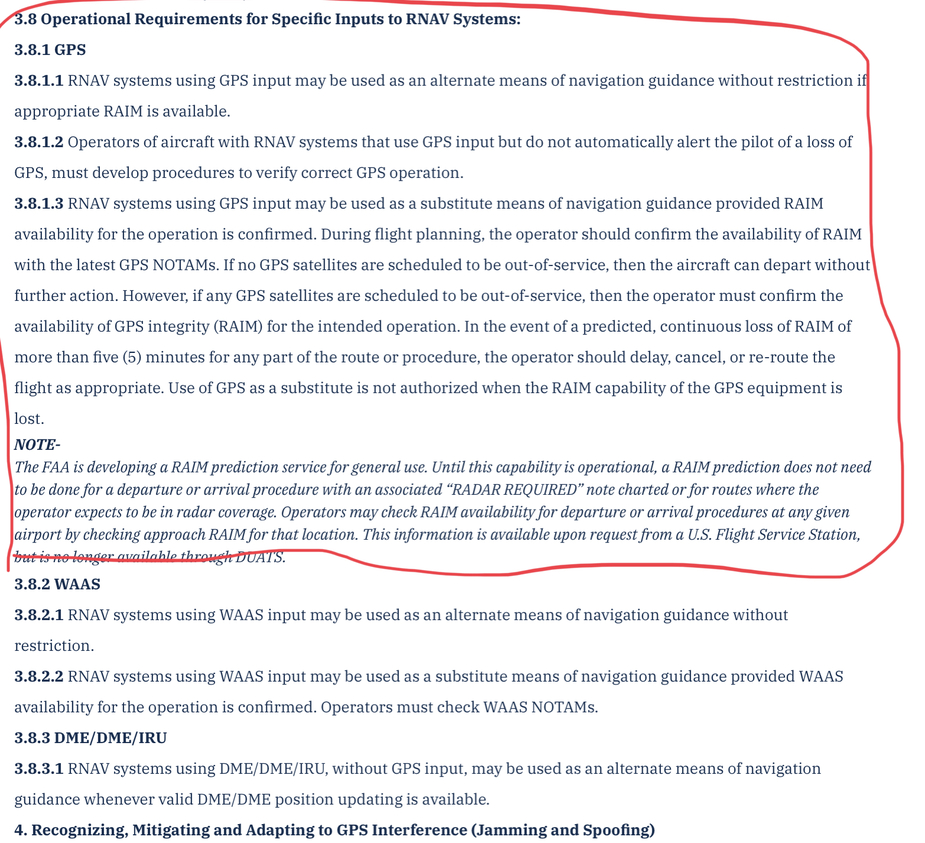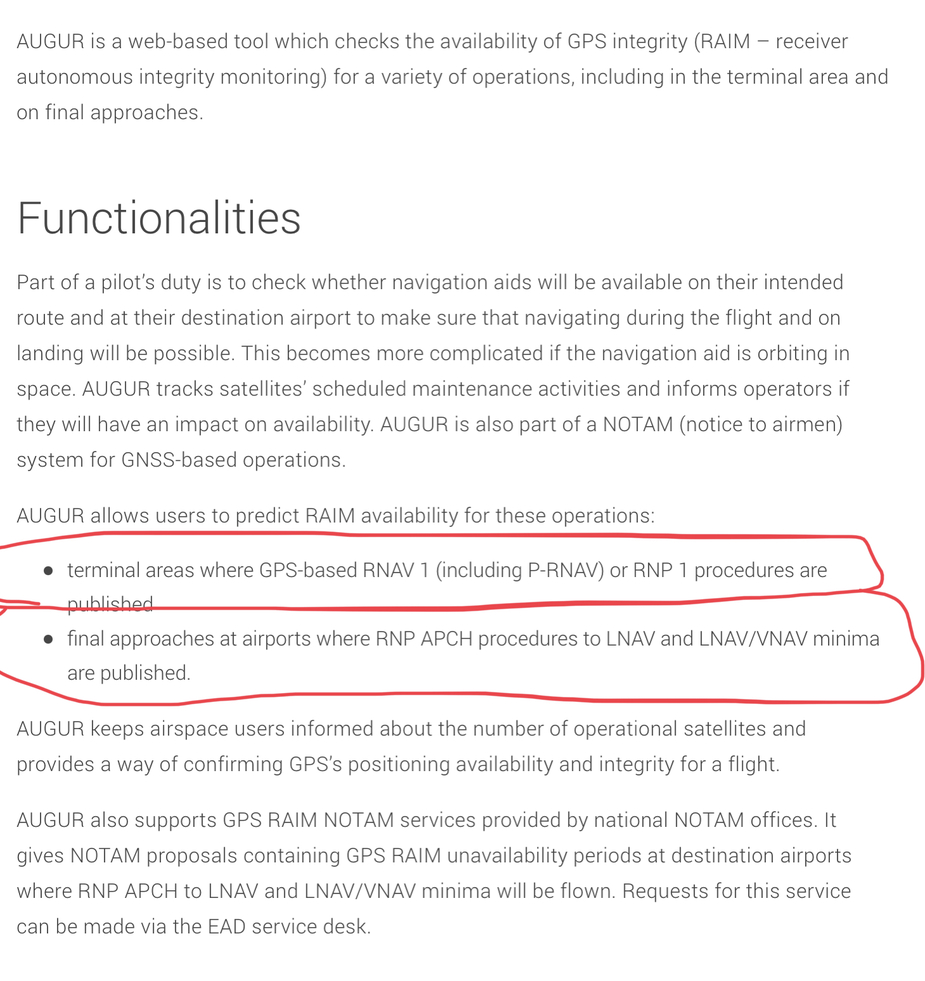Are we talking about what make sense? or legal requirements?
Legally, all I know is you need conventional approach if planning RNP, for en-route you can fly RNAV5 route with GPS alone, you don’t need anything else !
There is no radar, airspace or clouds in the statement…you will need “secondary navigation backup” on top of your “primary navigation” but it’s not route requirement…
How people used to manage it in the old days? are you saying in the past when flying VOR-VOR Airway (in clouds & airspace, they are irrelevant but let’s add them for better “story mix”) you need Radar backup if your VOR CDI fails? I doubt anyone know about this…
An aircraft with only an IFR GPS on it’s pannel and nothing else is fully PBN compliant “as is” (for flying in clouds without radar inside airspace if you want to add) as long as your alternate TAF is VMC
Ibra wrote:
An aircraft with only an IFR GPS on it’s pannel and nothing else is fully PBN compliant “as is” (for flying in clouds without radar inside airspace if you want to add) as long as your alternate TAF is VMC
Sorry, missing something, if you are in the cloud, with no GPS or radar, how would you make it to the alternate?
That is not the point…we are talking legality of equipment to be carried to fly an FPL while at it remind me what equipment you need to fly Sandown to Elstree in clouds outside controlled airspace and outside published routes without GPS?
PS: I would call DnD on 121.5 and ask for position fix or QDM outside controlledairspace (or ATC for vectors in airspace as it’s always radar)
@lbra we are talking legality IFR in CAS, not the UK parallel universe of IFR in IMC OCAS
But all CAS has now been migrated to PBN and GPS alone fits the bill to file an I-FPL in any PBN airspace (you need DME for Paris TMA if you lose radio but that is a different story)
In October2022, you don’t even need to plan ILS, VOR, NDB or VMC for approach to the alternate
RobertL18C wrote:
Now in theory most light GA will not be able to fly IFR CAS without radar service being available?!PART.NCO and PART.CAT require IFR GPS/RNAV and an alternative means of compliance to maintain RNP5 on an airway, which can be a radar service (you would need to advise loss of GPS to ATC and request radar vectors). Traditionally this was a VOR within 60 nm (RNP5), but if no VORs?? I guess some old timers have a LORAN still fitted :) but you might need a lot of paperwork to establish that was RNP5 in that area at that time.
In theory, RNAV 5 can only be used when radar (or possibly ADS-B) surveillance is available. So in all airspace which requires RNAV 5, radar service will be available. In enroute airspace without radar (or ADB-B) surveillance, you would need an RNP specification such as RNP 2 or RNP 4 (there is no such thing as RNP 5).
But I don’t think there are any plans to do away with all VORs, is there? E.g. Sweden will keep a skeleton network of VORs for contingencies such that all aircraft operating in CAS will always be in range of at least one VOR/DME station.
In theory, RNAV 5 can only be used when radar (or possibly ADS-B) surveillance is available. So in all airspace which requires RNAV 5, radar service will be available. In enroute airspace without radar (or ADB-B) surveillance, you would need an RNP specification such as RNP 2 or RNP 4
Do you have a reference that RNAV5 = Surveillance environment? (Radar or ADSB)
“Radar Required” & “RAIM required” seems to appear in US rules & procedures regarding RNAV operations (including RNAV5 cruise), but these things creep into European rules & procedures, however, it seems 1/ it’s about legacy TSO129 GPS non-WAAS and 2/ FAA use RNAV to mean “RNP” and “RNAV”, which is very confusing for anybody else who uses “ICAO/PBN terminology”
https://www.faa.gov/air_traffic/publications/atpubs/aip_html/part2_enr_section_1.17.html

In Europe, I doubt the operator needs “Radar” & “RAIM” as prescribed by FAA?
The only thing, I know is you are 100% legal to fly PBN (RNAV & RNP) with “GPS only” in your FPL without radar coverage, of course, if it’s TSO129 box and no-SBAS, you have to check RAIM for RNAV1 (or whatever leftovers from PRNAV) and RNP0.3, if it’s good you fly
https://www.eurocontrol.int/online-tool/augur

Ibra wrote:
Do you have a reference that RNAV5 = Surveillance environment? (Radar or ADSB)
I never wrote that “RNAV 5 = Surveillance environment”. I said that the difference between RNAV and RNP specifications is that RNP specifications have “On-board performance monitoring and alerting” and alerting, while RNAV specifications do not. This means that RNAV specifications are intended to be used where surveillance is available while RNP specifications are intended to be used where surveillance is not available (or practical)
“Radar Required” & “RAIM required” seems to appear in US rules & procedures regarding RNAV operations (including RNAV5 cruise), but these things creep into European rules & procedures, however, it seems 1/ it’s about legacy TSO129 GPS non-WAAS and 2/ FAA use RNAV to mean “RNP” and “RNAV”, which is very confusing for anybody else who uses “ICAO/PBN terminology”
Yes, this is very confusing. Also in ICAO terminology the usage has varied, e.g. RNP approaches used to be called (e.g. in PANS-OPS up to the 5th edition) things like RNAV(GNSS) approaches. This is a terminology still used by the FAA. Jeppesen and other database providers have refused to adopt to the change in ICAO terminology also outside the USA, so RNP approaches in Europe are still called “RNAV GPS” approaches in GPS navigator databases although the approach plates (both AIP and Jeppesen) call them “RNP” approaches.
This means that RNAV specifications are intended to be used where surveillance is available while RNP specifications are intended to be used where surveillance is not available (or practical)
Yes that make sense and was the intention but I don’t think any country has gone with that implementation for legacy and cost reasons:
- RNAV5 Airways flown without Radar surveillance in PBN airspace (usually Echo or Golf) with reduced traffic bandwidth, I am not sure why the lack of radar is a problem for GPS equipment? but not for VOR equipment? without radar, these are subject to “additional requirements” by individual states
- RNAV1 departure & arrival are used bellow Radar MVA (or MSA/MEA) or outside Radar coverage and were not designed as RNP1 because of lack of approvals in most navigators, without radar, these are subject to “additional requirements” by individual states
I am not sure what are the “additional requirements” for every country if no surveillance is available? but few random things will come to mind 1/ two independent sources of navigation? 2/ NDB for GPS RNAV1 missed? 3/ check RAIM for RNAV1/5 during planing? 4/ plan CONV + GPS routes? 5/ fly on PLOG? 6/ plan VMC?
These are not specific to GPS equipment per say, someone flying RNAV5 Airway on his 2×VOR will also need to back it up (something like GPS?) but it seems everybody ignore this one: grandfathered right before PBN was introduced 
Ibra wrote:
In Europe, I doubt the operator needs “Radar” & “RAIM” as prescribed by FAA?
If you are using the US AIP source to indicate that RNAV requires Radar, this is a misinterpretation of what the AIP is saying.
NOTE−
The FAA is developing a RAIM prediction service for
general use. Until this capability is operational, a RAIM
prediction does not need to be done for a departure or
arrival procedure with an associated “RADAR REQUIRED”
note charted or for routes where the operator
expects to be in radar coverage.
This is outdated material. Unfortunately, the US does a poor job of maintaining its AIP. The FAA has (past tense) provided a RAIM prediction site for many years and has added to it in 2020 to support the ADS-B Out mandate for some aircraft that are not fully compliant or are not equipped. An equivalent to the above statement does not appear in the AIM or in current advisory guidance. The note “radar required” only appears on some SID, STAR, and approach procedures. This guidance only applied to excuse RAIM being needed for a SID .or STAR where radar was available. At one point, the FAA would not issue a clearance to aircraft to depart IFR unless the departure airport was within the service volume of a conventional Navaid, so 40 NM of a VOR unless radar surveillance was provided. Once RNAV approaches began being used, it became possible to land at an airport only served by GPS, but no way to get an IFR departure clearance because of lack of radar coverage. That was changed and now GPS may be used as long as the random point to point route includes at least one named point within 500 NM of the departure point.
This is from the FAA controller guidance, 7110.65Z in 4−4−1. ROUTE USE:
c. Random routes.
1. When not being radar monitored, GNSS-equipped RNAV aircraft on random RNAV routes must be cleared via or reported to be established on a point-to-point route.
(a) The points must be published NAVAIDs, waypoints, fixes or airports recallable from the aircraft’s navigation database. The points must be displayed on controller video maps or depicted on the controller chart displayed at the control position. When applying nonradar separation the maximum distance between points must not exceed 500 miles.
Current guidance is for the non WAAS GPS systems to do a RAIM check for the route before departure and to delay the flight if there is an outage expected that will last for more than 5 minutes.
The FAA does a better job on keeping the AIM current. There is no requirement for using radar when using a GPS for RNAV. The US uses RNAV 2 for enroute airways and RNAV 1 for RNAV based SIDs and STARs. A few RNAV SIDs have a RNP 1 requirement when they incorporate RF turns. RNAV 5 is not used in the US for any airway routes. RNP APCH is used for the approach specification, but the FAA has kept its naming convention of RNAV (GPS).